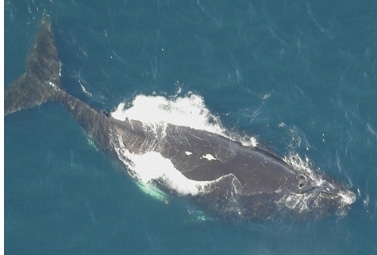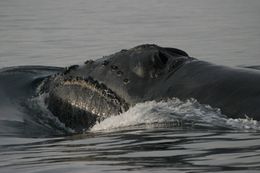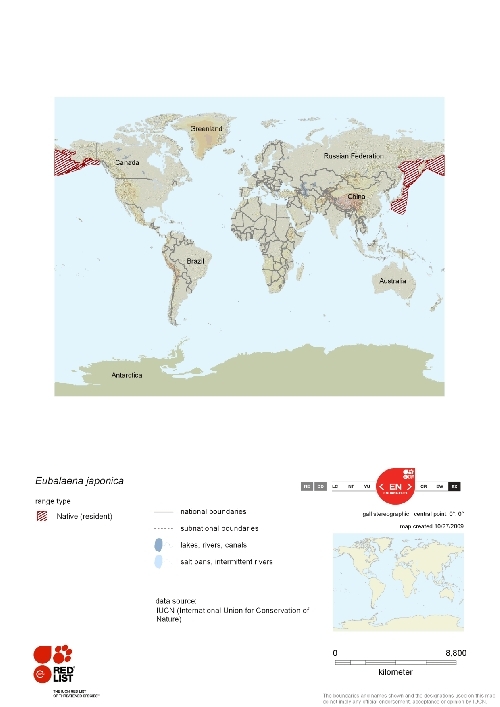North Pacific right whales
Contents
- 1 North Pacific right whale
- 1.1 Physical Description
- 1.2 Taxonomy
- 1.3 Behavior
- 1.4 Voice and Sound Production
- 1.5 Reproduction
- 1.6 Lifespan/Longevity
- 1.7 Distribution and Movements
- 1.8 Habitat
- 1.9 Food and Feeding Habits
- 1.10 Predation
- 1.11 Economic Importance for Humans
- 1.12 Threats and Conservation Status
- 1.13 Further Reading
North Pacific right whale
The North Pacific right whale (scientific name: Eubalaena japonica) is an endangered marine mammal in the family Balaenidae, part of the order of cetaceans.The North Pacific right whale is a baleen whale, meaning that instead of teeth, it has long plates which hang in a row (like the teeth of a comb) from its upper jaws. Baleen plates are strong and flexible; they are made of a protein similar to human fingernails. Baleen plates are broad at the base (gumline) and taper into a fringe which forms a curtain or mat inside the whale's mouth. Baleen whales strain huge volumes of ocean water through their baleen plates to capture food: tons of krill, other zooplankton, crustaceans, and small fish.
This whale species obtained its name for being the "right" whales to catch. Once killed, their considerable amount of blubber caused them to float at the surface and resulted in huge yields of oil. The right whales have been driven nearly to extinction, since the species was preferred by commercial whalers and was hunted in spite of international bans. There are perhaps several hundred individuals left in the western Pacific, and perhaps only a handful in the eastern Pacific. Between 1960 and 1996, only a few solitary animals were sighted; in 1996, a group of four was found in the Bering Sea.
These animals are among the largest mammals and can weigh as much as 100 tons at maturity. They can live 70 years or longer. The North Atlantic right whale differs in skin color from the North Pacific right whale and the cold waters of the Arctic Circle are a natural impediment to the mingling of these two groups.
Physical Description
These are large, baleen whales, up to 17 meters long and 90,000 kilograms (approximately 100 tons). Their skin is largely black, although individuals may have white patches on their undersides. They are marked by large callosities on the rostrum, near the blowholes and eyes, and on the chin and lower lip. The largest callosity, on the top of the rostrum, is referred to as a "bonnet." These callosities harbor barnacles (Cirripedia) and whale lice (Cyamidae) and may appear white, yellow, or pink.
These are robust baleen whales, with broad, rounded flippers, no dorsal fin, and lacking a grooved throat. Baleen plates can reach three meters in length and number up to 270 on each side of the mouth.
The head and jaws are massive, making up almost one third of the length of this whale. Females are larger than males. Their blubber can be up to 71 centimeters thick and make up to 45% of their body mass.
Their blowholes are separated on their dorsal surface and exhalations result in a large, V-shaped blows up to five meters high. Their seven cervical vertebrae are fused into a single unit. Length Range: 17-18.3 meters (50 -60 feet).
Taxonomy
Northern Pacific right whales were only recently recognized as a distinct species based on genetic evidence so much of the data on their natural history refers to the previously recognized single species, Eubalaena glacialis.
What was long treated as a single right whale species is now recognized as three distinct species by both scientists and federal regulatory agencies. They are:
- North Atlantic right whale (Eubalaena glacialis) which inhabits the Atlantic Ocean, especially between 20o and 60o N latitude.
- North Pacific right whale (Eubalaena japonica), which inhabits the Pacific Ocean, especially between 20o and 60o N latitude.
- Southern right whale (Eubalaena australis) occurring in the southern hemisphere between around 20o and 60o S latitude.
The Bowhead whale is also a member of the family Balaenidae.
Behavior
Relatively little is known about the behavior of this species, in large part because of their extreme rarity. Right whales are slow swimmers, only acheiving speeds up to five knots (just over nine km/hr) and averaging two knots (3.7 km/hr). Northern Pacific right whales migrate between summer and wintering grounds.
They have been observed singly or in small groups. Most recent sightings are of individual animals, but population estimates suggest that local populations are extremely small. A 1999-2003 survey documented only 3.3 right whales per 1610 kilometers of survey in the western Pacific. Eastern Pacific populations may number in the 10's of individuals.
In other Right Wahle species, groups are generally small, less than 12, and can be fluid and mixed-sex. Right whales are generally described as non-aggressive, even tender, towards other right whales, including potential mates, competing males, and young. (Butterworth et al., 2008; Crane and Scott, 2002; Slijper, 1979; Smith, 2000)
Voice and Sound Production
Northern Pacific right whales use vocalizations extensively, as do other Cetacea. Their vocalizations include both complex and simple, low-frequency sounds. The low-frequency sounds have been described as belch-like. Other sounds include moans, grunts, sighs, and bellows. In Eubalaena australis the energy range used is 50 to 500 Hz, with durations from 0.5 to 6.0 seconds.
In a study of northern Pacific right whale vocalization in the Bering Sea, over 80% of vocalizations were "up-calls," calls that were frequency modulated and ended on a higher frequency. These calls were from 90 to 150 Hz and about 0.7 seconds in duration. The remainder of calls were either "down-up calls," with a downward frequency change before becoming an up call (5%) or constant frequency moans.
Northern Pacific right whale calls are generally less than 250 Hertz and occur at irregular intervals of more than ten seconds apart. (Munger et al., 2008; Slijper, 1979)
Reproduction
The species mating system is polygynandrous (promiscuous). Mating systems have not been described in great detail for the North Pacific right whale. However, it is likely that mating is similar to other right whale species: North Atlantic Right Whale (Eubalaena glacialis) and Southern right whale (Eubalaena australis). In these species males and females form non-aggressive mating aggregations characterized by nuzzling and gentle physical contact. Females are likely to mate with multiple males and males do not compete aggressively for females.
Behaviors associated with mating in Eubalaena include fin and tail slapping at the surface, "headstanding," and breaching. In headstanding, right whales float at the water surface in a vertical position with the flukes extended into the air. They may also rock back and forth while in this position and will hold it for several minutes. It is thought to be a mating display. Breaching and tail/fin slapping is also more common during mating aggregations and may be a kind of courtship display. (Butterworth et al., 2008; Crane and Scott, 2002; Cummings, 1985; Slijper, 1979; Smith, 2000)
Like other Right Whales, northern Pacific right whales have exceptionally low reproductive rates. They give birth in winter to a single young every three to four years after a gestation period of just over a year. While breeding has not been observed in northern Pacific right whales, but is presumed to occur during winter, with births occurring the next spring.
It is unknown how long it takes for individuals to reach sexual maturity. In northern Atlantic right whales (Eubalaena glacialis) males and females reach sexual maturity at body lengths of about 15 meters, corresponding to ages of five to ten years of age. (Crane and Scott, 2002; Cummings, 1985; Slijper, 1979; Smith, 2000)
Northern Pacific right whales are up to six meters long when they are born and they grow quickly for their few years, reaching lengths up to 12 meters at 18 months old.
Mothers nurse, protect, and care for their young, investing significant energy into each offspring. Little is known about the duration of lactation and care, but it is likely to be long, given the 3 to 4 year interval between breeding attempts in females. There may be a long period of association with the mother and an extended period of learning. (Crane and Scott, 2002; Cummings, 1985; Slijper, 1979)
Lifespan/Longevity
Data on maximum lifespan of northern Pacific right whales is lacking. Lifespan is likely to be long. An individual Eubalaena glacialis was confirmed living to at least 67 years old and their close relatives, Bowhead whales (Balaena mysticetus) have been confirmed living to nearly 200 years old. (Crane and Scott, 2002)
Distribution and Movements
Northern Pacific right whales are found throughout most of the North Pacific between 20 and 60 degrees latitude.
They migrate to higher latitudes in the summer and to lower latitudes and coastal areas in winter. In summer, northern Pacific right whales are found in the Sea of Okhotsk, Bering Sea, around the Aleutian Island chain, and in the Gulf of Alaska.
In winter they are found (or were once found) in the Sea of Japan, Taiwan straits, and Ogasawara Bunto in the western Pacific and south to coastal Baja California in the eastern Pacific. They have also been seen occasionally in the Hawaiian Islands.
Populations in the eastern and western Pacific are considered discrete populations. Northern Pacific right whales were formerly abundant in this range but they are now rare and primarily observed in the Okhotsk Sea, southeastern Bering Sea, and occasionally along coastal Japan.
Habitat
There is little known about habitat use by northern Pacific right whales. Historical whaling catch data suggest that the majority of the population was found in the Bering Sea, Gulf of Alaska, Sea of Okhotsk and northern North Pacific during summer. There is no evidence of coastal breeding aggregations in winter, as in their close relative Eubalaena australis. They may breed in offshore areas. Winter habitat use is unknown. In the southeastern Bering Sea, northern Pacific right whales seem to pass through the area for only a few days at a time and mainly from July to October (but as early as May and as late as December).
Food and Feeding Habits
North Pacific right whales feed mainly at the surface on concentrations of zooplanktonic crustaceans, such as Euphasiidae, Calanoida, and larval Cirripedia. They take in large amounts of sea water and then express the water from their mouths with the tongue, leaving their zooplankton prey behind. Northern Pacific right whales have baleen plates with exceptionally fine fringes to collect their very small prey. (Butterworth et al., 2008; Crane and Scott, 2002; Cummings, 1985; Slijper, 1979; Smith, 2000)
Predation
Because of their very large size, adult right whales have no natural predators. Newborn calves may fall prey to killer whales or large sharks. In the last several hundred years humans have been the primary predators of northern Pacific right whales. (Butterworth et al., 2008; Gaines et al., 2005; NOAA Fisheries and OPR, 2008)
Eubalaena are important predators of krill and microcrustacean faunas. The relative rarity of northern Pacific right whales may mean that their impact on these faunas is currently small. Right whales have communities of barnacles and whale lice on their bodies. The extent of the negative effect of these communities on whales is uncertain, but they are thought to use breaching to try and dislodge parasites. (Cummings, 1985)
Economic Importance for Humans
There are no known adverse effects of northern Pacific right whales on humans. This cetacean species has been previously hunted for oil and other parts. Hunting of right whales has been outlawed by international conventions since 1935. (Butterworth et al., 2008; Gaines et al., 2005; NOAA Fisheries and OPR, 2008)
Threats and Conservation Status
North Pacific right whales represent one of the rarest whales species, with some estimates placing the world population at around 1400 individuals and other estimates substantially smaller (around 500 in the western Pacific and numbering less than 100 in the eastern Pacific). Only 1,965 northern Pacific right whales were observed in the 20th century. (Butterworth et al., 2008; NOAA Fisheries and OPR, 2008; OBIS-SEAMAP, 2009)
They were previously common in the north Pacific but were relentlessly pursued by whalers throughout the 19th century. Japanese whaling of this species began in the late 1500's, and whaling by Americans and Europeans began in the 1800's. As many as 37,000 northern Pacific right whales were killed in a 70 year period from 1839 to 1909, leaving populations at a minute fraction of their previous levels.
Right whales became protected by international agreement in 1935 and by law in 1946 by the International Whaling Commission. Illegal hunting continued through the 1960's, during which time Soviet whaling ships took almost the entire remaining population of eastern Pacific right whales (372 individuals), leaving the population at an estimated 50 individuals. These whales have been protected from hunting since 1970, but entanglements and deaths continue to occur occasionally.
The eastern Pacific population is considered critically endangered and populations in the western Pacific are considered endangered by the IUCN. The IUCN Red List: classifies the species as Endangered; the USA government also lists the species as Endangered. This whale is listed by CITES in Appendix I. The subpopulation, Northeast Pacific right whale, is considered Critically Endangered (CR)
Further Reading
- Eubalaena japonica (Lacépède, 1818), Encyclopedia of Life
- Reilly, S.B., Bannister, J.L., Best, P.B., Brown, M., Brownell Jr., R.L., Butterworth, D.S., Clapham, P.J., Cooke, J., Donovan, G.P., Urbán, J. & Zerbini, A.N. 2008. Eubalaena japonica. In: IUCN 2010. IUCN Red List of Threatened Species. Version 2010.4. Downloadedon 30May2011.
- Dewey, T. 2009. "Eubalaena japonica" (On-line), Animal Diversity Web. Accessed May 30, 2011 .
- Baillie, J. and Groombridge, B. (comps and eds). 1996. 1996 IUCN Red List of Threatened Animals. IUCN, Gland, Switzerland and Cambridge, UK.
- Brownell Jr., R. L., Clapham, P. J., Miyashita, T. and Kasuya, T. 2001. Conservation status of North Pacific right whales. Journal of Cetacean Research and Management Special Issue 2: 269-286.
- Burdin, A. M., Nikulin, S., Jacobs Soauding, M. and Brownell Jr., R. L. 2004. Incidental entanglement of Okhotsk Sea right whales: a future conservation issue? International Whaling Commission Scientific Committee.
- Clapham, P. J., Good, C., Quinn, S. E., Reeves, R. R., Scarff, R. R. and Brownell Jr., R. L. 2004. Distribution of North Pacific right whales (Eubalaena japonica) as shown by 19th and 20th century whaling catch and sighting records. Journal of Cetacean Research and Management 6(1): 1-6.
- Crane, J., R. Scott. 2002. Eubalaena glacialis (On-line). Animal Diversity Web. Accessed March 24, 2009 .
- Cummings, W. 1985. Right whales. New York: Academic Press.
- Doroshenko, N. V. 2000. Soviet Whaling for blue, gray, bowhead and right whales in the North Pacific Ocean, 1961-1979. Soviet Whaling Data (1949-1979), pp. 96-103. Center for Russian Environmental Policy, Moscow, Russia.
- Herman, L. M., Baker, C. S., Forestell, P. H. and Antinoja, R. C. 1980. Right whale Balaena glacialis sightings near Hawaii: a clue to the wintering grounds? Marine Ecology Progress Series 2: 271-275.
- International Whaling Commission. 2004. Classification of the order Cetacea. Journal of Cetcaean Research and Management 6(1): xi-xii.
- Gaines, C., M. Hare, S. Beck, H. Rosenbaum. 2005. Nuclear markers confirm taxonomic status and relationships among highly endangered and closely related right whale species. Proceedings of the Royal Society: Biological Sciences, 272: 533-542.
- IUCN (2008) Cetacean update of the 2008 IUCN Red List of Threatened Species.
- Kaltona, S., S. Kraus. 1999. Efforts to Conserve the North Atlantic Right Whale. Washington, D.C.: Smithsonian Institution Press.
- Lacépède, 1818. Memoirs du Museum dâ??Histoire Naturelle. Paris, 4:409, 473.
- Leduc, R. G., Perryman, W. L., Gilpatrick, J. W., Hyde, J., Stinchcomb, C., Carretta, J. V. and Brownell Jr., R. L. 2001. A note on recent surveys for right whales in the southeastern Bering Sea. Journal of Cetacean Research and Management 2: 287-289.
- Mead, James G., and Robert L. Brownell, Jr. / Wilson, Don E., and DeeAnn M. Reeder, eds. 2005. Order Cetacea. Mammal Species of the World: A Taxonomic and Geographic Reference, 3rd ed., vol. 1. 723-743
- Miyahsita, T. 2004. Cruise report of the common minke whale sighting surveys in the Sea of Okhotsk in 2003. International Whaling Commission Scientific Committee, Sorrento, Italy.
- Miyashita T. and Kato H. 1998. Recent data on the status of right whales in the NW Pacific Ocean. International Whaling Commission, Cambridge, UK.
- Miyashita, T., Nishiwaki, S., Vladimirov, V. A. and Doroshenko, N. V. 2001. Cruise report on the minke whale sighting surveys in the Sea of Okhotsk, 2000. International Whaling Commission Scientific Committee, London, UK.
- Miyashita, T., Okamura, H., Vladimirov, V. A. and Doroshenko, N. V. 2000. Cruise report of the Japan-Russia joint sighting survey in the Sea of Okhotsk in 1999. International Whaling Commission Scientific Committee, Adelaide, Australia.
- Munger, L., S. Wiggins, S. Moore, J. Hildebrand. 2008. North Pacific right whale (Eubalaena japonica) seasonal and diel calling patterns from long-term acoustic recordings in the southeastern Bering Sea, 2000–2006. Marine Mammal Science, 24: 795-814.
- NOAA Fisheries, OPR, 2008. Northern Pacific right whale (On-line). NOAA Fisheries, Office of Protected Resources. Accessed March 24, 2009
- OBIS-SEAMAP, 2009. Eubalaena japonica (On-line). OBIS-SEAMAP. Accessed March 25, 2009.
- Perrin, W. (2010). Eubalaena japonica (Lacépède, 1818). In: Perrin, W.F. World Cetacea Database. Accessed through: Perrin, W.F. World Cetacea Database at http://www.marinespecies.org/cetacea/aphia.php?p=taxdetails&id=254974 on 2011-02-05
- Reilly, S., J. Bannister, P. Best, M. Brown, J. Brownell Jr., D. Butterworth, P. Clapham, G. Donovan, J. Urbán, A. Zerbinia. 2008. Eubalaena japonica (On-line). 2008 IUCN Red List of Threatened Species. Accessed March 24, 2009 at http://www.iucnredlist.org/details/41711 .
- Rice, D. W. 1998. Marine mammals of the world: systematics and distribution. Society for Marine Mammalogy.
- Rosenbaum, H. C., Brownell Jr., R. L., Brown, M. W., Scaeff, S. C., Portway, V., White, B. N., Malik, S. and Pastene, L. A. 2000. World-wide genetic differentiation of Eubalaena: Questioning the number of right whale species. Molecular Ecology 9: 1793-1802.
- Rowntree, V., Darling, J., Silber, G. and Ferrari, M. 1980. Rare sighting of a right whale (Eubalaena glacialis) in Hawaii. Canadian Journal of Zoology 58: 309-312.
- Salden, D. R. and Mickelsen, J. 1999. Rare sighting of a North Pacific right whale (Eubalaena glacialis) in Hawai'i. Pacific Science 53: 341-345.
- Scarff, J. E. 2001. Preliminary estimates of whaling-induced mortality in the 10th century North Pacific right whale (Eubalaena janonicus) fishery, adjusting for struck-but-lost whale and non-American whaling. Journal of Cetacean Research and Management 2: 261-268.
- Slijper, E. 1979. Whales. Ithaca, NY: Cornell University Press.
- Smith, J. 2000. Eubalaena australis (On-line). Animal Diversity Web. Accessed March 24, 2009
- UNESCO-IOC Register of Marine Organisms
- Wade, P. R., Heide-Jorgensen, M. P., Shelden, K. E. W., Barlow, J., Carretta, J., Durban, J. W., Leduc, R. G., Munger, L., Rankin, S., Sauter, A. and Stinchcomb, C. 2006. Acoustic detection and satellite-tracking leads to discovery or rare concentration of endangered North Pacific right whales. Biology Letters.
- Waite, J. M., Wynne, K. and Mellinger, D. K. 2003. Documented sightings of a North Pacific right whale in the Gulf of Alaska and post-sighting acoustic monitoring. Northwestern Naturalist 84: 38-43.
- Wang, P. 1978. Studies on the baleen whales in the Yellow Sea. Acta Zoologica Sinica 24: 269-277.
- Wang, P. 1988. Cetacea. In: Z. Xiao (ed.), Fauna Liaoningica, pp. P. 342. Liaoning Science and Technology Press, Shenyang, China.
- Wilson, Don E., and DeeAnn M. Reeder, eds. 1993. Mammal Species of the World: A Taxonomic and Geographic Reference, 2nd ed., 3rd printing. xviii + 1207




